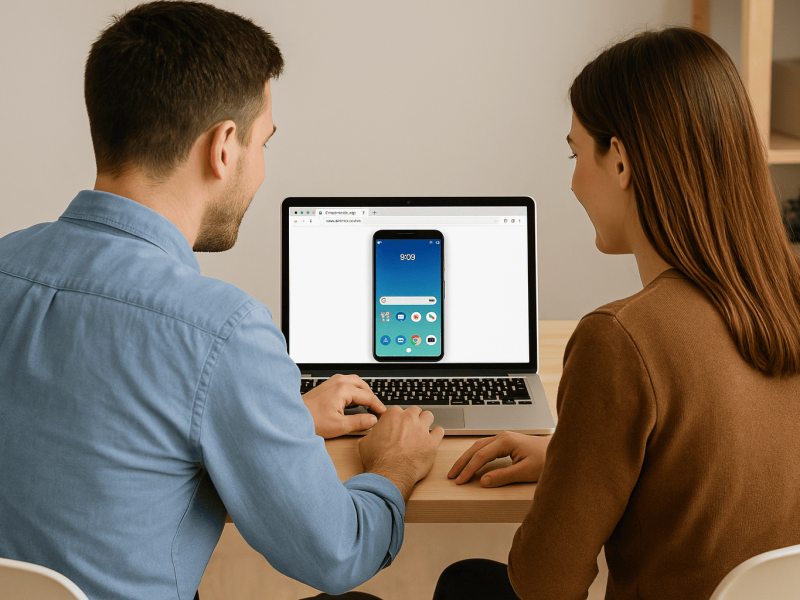Do you want to test your Android apps online, and that too for free? With the multitude of online tools available, finding the right one can be a daunting task.
However, fear not, because in this discussion we will uncover a range of free online resources that will help you test your Android apps with ease. Whether you’re a seasoned developer or just starting, there’s something here for everyone.
Choosing the Right Online Android Emulator
When selecting the ideal online Android emulator, consider the specific features and performance requirements of your app. You want an emulator that allows you the freedom to test your app across various Android devices and screen sizes.
Look for one that supports the latest Android versions and has the capability to simulate different network conditions. The right emulator should provide seamless integration with your development environment, making it easy to debug and test your app.
It should also offer smooth performance, ensuring that your app functions as intended. Additionally, consider the emulator’s compatibility with hardware peripherals like GPS, camera, and accelerometer if your app relies on these features.
Accessing Free Online Device Clouds
You can access free online device clouds to test your Android apps efficiently.
Device cloud options provide a range of testing tools online. These allow you to run your app on various real devices without having to invest in physical devices or emulators.
This can help you ensure that your app works seamlessly across different devices and screen sizes.
Device Cloud Options
Access free online device clouds to test your Android apps on a variety of real devices without the need for physical hardware. Here are some amazing options for you to explore:
- MyAndroid.org: provides free Android Virtual Device (AVD) without any time limits to test mobile apps
- Sauce Labs: Access a wide range of Android devices and versions to ensure your app works seamlessly for all users.
- BrowserStack: Test your app on a diverse set of real Android devices, and experience the freedom of not being tied down to specific hardware.
- AWS Device Farm: Enjoy the flexibility of testing your app on a vast selection of real Android devices in the AWS cloud environment.
- Firebase Test Lab: With Firebase Test Lab, you can leverage Google’s infrastructure to run your app on a wide range of Android devices. It frees you from the constraints of physical testing.
- Kobiton: Kobiton gives you access to a large inventory of real Android devices for testing. It empowers you to ensure your app’s compatibility across various platforms.
Testing Tools Online
Transitioning from discussing device cloud options, explore the world of testing tools online, particularly accessing free online device clouds for efficient Android app testing.
Free online device clouds like MyAndroid, BrowserStack, Bitbar, and AWS Device Farm offer a wide range of real devices for testing, eliminating the need to purchase physical devices.
These tools allow you to run your app on various Android devices, operating systems, and screen sizes, ensuring compatibility and functionality across different platforms.
With these free online device clouds, you have the freedom to test your app on multiple devices simultaneously, saving time and effort.
Additionally, they provide features such as automated testing, debugging tools, and real-time collaboration, enhancing the testing process.
Leveraging these free online device clouds empowers you to conduct thorough and comprehensive testing without being constrained by device limitations.
Utilizing Browser-Based Testing Tools
When it comes to utilizing browser-based testing tools, it’s important to first understand the overview of how these tools work.
You can then compare the key features of different browser-based testing tools to determine which one best suits your needs.
Browser-Based Testing Overview
To enhance the efficiency and accuracy of testing your Android apps, consider utilizing browser-based testing tools for a seamless and comprehensive testing process.
Browser-based testing offers you the freedom to test your apps from anywhere, at any time. You can easily collaborate with team members and stakeholders, providing them with real-time access to the testing process.
Browser-based testing tools also allow for quick and easy setup, saving you time and effort. With the ability to run tests on multiple devices and operating systems simultaneously, you can ensure your app’s compatibility across various platforms.
Additionally, these tools provide detailed reporting and analytics, giving you valuable insights to improve your app’s performance.
Embrace the freedom of browser-based testing for a more efficient app testing experience.
Key Features Comparison
Compare the key features of different browser-based testing tools to make an informed decision about which tool best suits your Android app testing needs.
Look for tools that offer support for various Android versions, device emulators, and real device testing.
Ensure that the tool provides comprehensive debugging capabilities, such as network traffic inspection, console logs, and element inspection.
Consider the ease of use and integration with your existing development workflow, including support for popular frameworks and CI/CD pipelines.
Look for tools that offer collaborative features, allowing team members to share test results and collaborate on issue resolution.
Additionally, prioritize tools that provide detailed test reports and analytics to help you identify and address performance and compatibility issues.
Testing Process Steps
Consider utilizing browser-based testing tools to streamline the testing process steps for your Android apps. These tools can save you time and effort, allowing for a more efficient testing process.
Here are some benefits of using browser-based testing tools:
- Freedom to test from anywhere, anytime
- Flexibility to choose from a variety of devices and operating systems
- Ease of collaboration with team members
- Quick access to real-time test reports and analytics
- Ability to integrate with your existing development workflow
Exploring Virtual Testing Environments
Exploring virtual testing environments allows you to simulate different device configurations and network conditions to thoroughly test your Android apps’ performance and functionality. By using virtual testing environments, you can ensure that your app works seamlessly across various devices and under different network speeds, ultimately providing a better user experience. Below is a table showcasing some popular virtual testing platforms that offer free trials for you to explore:
| Virtual Testing Platform | Features | Free Trial Period |
|---|---|---|
| MyAndroid.Org | Device testing, APK uploads, simulation of android devices | Unlimited |
| Firebase Test Lab | Device testing, Robust analytics, Real-world simulation | 1 month |
| AWS Device Farm | Automated testing, Remote access to real devices, Flexible environment | 1000 device minutes |
| BrowserStack | Cross-browser testing, Real device testing, Parallel testing | 100 minutes |
These platforms empower you to test your Android apps in a virtual environment without constraints, giving you the freedom to ensure your app’s quality and performance across diverse scenarios.
Leveraging Online App Testing Platforms
When choosing an online app testing platform, prioritize features that align with your app’s specific testing needs and objectives. Look for platforms that offer the freedom to customize testing scenarios and environments to match your app’s requirements.
Here are some key features to consider when selecting an online app testing platform:
- Flexible Testing Environments: Choose a platform that allows you to test your app on a wide range of devices and operating system versions, giving you the freedom to ensure compatibility across various setups.
- Comprehensive Test Reporting: Opt for a platform that provides detailed and easy-to-understand test reports, empowering you to make informed decisions about your app’s performance and functionality.
- Collaboration Capabilities: Select a platform with collaborative features that allow your team members the freedom to work together seamlessly, share feedback, and track testing progress in real-time.
- Automated Testing Support: Look for platforms that offer automated testing capabilities, freeing up your time and resources while ensuring thorough test coverage.
- Scalability and Cost-Effectiveness: Prioritize platforms that offer flexible pricing plans, allowing you the freedom to scale your testing efforts as your app grows without breaking the bank.
Testing Android Apps on Multiple Devices
To ensure comprehensive testing coverage, evaluate your Android app on multiple devices with varying specifications and operating system versions. By testing on a variety of devices, you can uncover potential compatibility issues and ensure a seamless user experience for all your users.
Online app testing platforms like Firebase Test Lab and BrowserStack offer the ability to test on a wide range of real Android devices, allowing you to see how your app performs across different screen sizes, hardware capabilities, and OS versions.
Testing on multiple devices also enables you to identify and address any device-specific bugs or performance issues, ensuring that your app functions optimally for all users. Additionally, it allows you to verify that your app’s layout and functionality adapt appropriately to different screen resolutions and aspect ratios.
Furthermore, testing on multiple devices can help you gain insights into how your app performs under various network conditions and battery levels, providing valuable data for optimizing performance and battery efficiency.
Ultimately, testing on multiple devices empowers you to deliver a high-quality app experience that meets the diverse needs of your users.
Frequently Asked Questions
Are There Any Limitations or Restrictions When Using Free Online Device Clouds for Testing Android Apps?
When using free online device clouds for testing android apps, there may be limitations or restrictions such as limited access to certain devices, slower performance, and potential security concerns. It’s important to consider these factors before proceeding.
How Can I Ensure That the Browser-Based Testing Tools I Use Are Secure and Reliable?
To ensure browser-based testing tools are secure and reliable, check for HTTPS in the URL, read user reviews, and verify the tool’s compliance with security standards. Trust your gut and always prioritize your data security.
What Are the Advantages of Using Virtual Testing Environments for Android App Testing?
Using virtual testing environments for Android app testing allows you to simulate various device configurations, saving time and resources. It also enables you to test in different network conditions and ensure compatibility across multiple devices.
Are There Any Specific Considerations for Testing Android Apps on Multiple Devices Simultaneously?
When testing Android apps on multiple devices simultaneously, you can efficiently identify compatibility issues and ensure a consistent user experience across various devices. This approach saves time and provides a more comprehensive understanding of your app’s performance.
How Can I Track and Manage Test Results Across Different Online App Testing Platforms?
You can track and manage test results across various online app testing platforms by utilizing a centralized test management tool. It allows you to aggregate results, track progress, and collaborate with team members efficiently.
Conclusion
So, next time you need to test your Android app, don’t break a sweat or break the bank.
With the right online emulator, device cloud, browser-based tools, and virtual environments, you can test your app on multiple devices for free.
It’s like having a whole team of expert testers at your fingertips, ready to give your app the thumbs up.
Happy testing!


